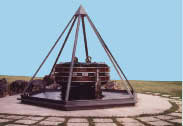|
|
|
|
Thursday, 1st April 2004 - h. 15:00 Auditorium B. Touschek Experimental
evidence of an exotic S=+1 baryon
Abstract The constituent quark model describes light mesons as bound states of qqbar pairs, and baryons as bound 3-quark states. On the other hand, high energy experiments have established that the virtual sea-quarks may play an important role too. It is then natural to ask whether more complex configurations exist, like for example 5-quarks (qqqqqbar) states, where the qbar has different flavor than the other quarks. The idea of 5-quark baryonic states have in fact been proposed since the late 60's by several authors. More recently, in 1997 Diakonov, Petrov and Polyakov predicted an antidecuplet of 5-quark baryons, with spin and parity J^p=1/2^+. The lowest mass member is an isosinglet Tetha^+ state with quark configurations (uuddsbar) giving S=+1, with mass of approximately 1.54 GeV and width of around 15 MeV. Experimental evidence for a S=+1 baryon resonance with mass 1.54 GeV and width less than 25 MeV has been reported for the first time by the LEPS Collaboration at SPring-8 in the photoproduction on neutron bound in a carbon target. Since then, several other experimental groups have found this exotic baryon in different reaction channels. An overview of the different experiments will be given. They provide evidence of the existence of an exotic S=+1 baryonic resonance in the KN invariant mass distribution, with mass around 1.54 GeV and small width. Further investigations are in progress in several Laboratories to confirm the existence of this exotic pentaquark state and to establish its quantum numbers (spin, parity and isospin). |
